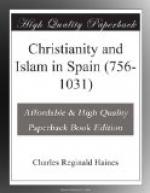[1] See “Life of Argentea,” secs. 3, 5.
[2] Dozy, ii. 287.
[3] Val du Junqueras, 920 A.D.
[4] Johannes Vasaeus ex Commentariis Resendi. Romey, iv. 257, disbelieves this version of the story. Perhaps Al Makk., ii. 154, is referring to the same Pelagius when he mentions the king’s liking for a handsome Christian page.
[5] Sampiro, secs. 26-28.
In the death of Argentea (Ap. 28, 931) we have the last instance in Spain of a Christian seeking martyrdom. She was the daughter of the great rebel Omar ibn Hafsun,[1] and his wife Columba, and was born at that chieftain’s stronghold of Bobastro. Upon her mother’s death Omar wished her to take up her mother’s duties in the palace, for Omar had become a sort of king on his own domain. She declined, asking only for a quiet retreat, where she might prepare her soul for martyrdom; and she wrote to a devout Christian, whose wishes inclined him in the same direction, suggesting that they should seek the crown of martyrdom together.[2] On the destruction of Bobastro by Abdurrahman in 928, she went to Cordova.[3] She there met with a Gaul named Vulfura, who had been warned in a dream that in that city he should find a virgin, with whom he was to suffer martyrdom. However, his object becoming known, Vulfura is cast into prison by the governor of the city. Argentea goes to visit him there, and is stopped by the guards, who, finding she is a Christian, take her before the judge as a renegade, and she is imprisoned with Vulfura. The alternative of Islam instead of death being refused, they are both executed, but Argentea, as being an “insolens rebellis,” is first scourged with 1000 stripes, and her tongue cut out. Her body was buried at the church of the three saints.
In the year 934[4] we hear of two hundred monks of Cardena being massacred by the Berbers in Abdurrahman’s army; and in some sense they can be regarded as martyrs to their faith.
[1] Who on becoming a Christian,
took the name of Samuel.
Florez, x. p. 564, ff.
[2] See “Life of Argentea,” by an anonymous author.
[3] Ibid., sec. 4.
[4] Dozy, iii. 52. Mariana,
viii. 6, gives 993, but says it may
have occurred in 893.
In 953 a martyr named Eugenia is said to have perished;[1] and thirty years later, the last martyrs of whom we have any record under the Arab rule. Dominicus Sarracinus, son of John, and his companions taken prisoners at the capture of Simancas, were kept for two years and a-half in prison.[2] They were then brought out and put to death, just when Ramiro III., or his successor, had sent to ransom them.[3]
There is no evidence whatever to show that there was a persecution of the Christians under the great Abdurrahman, and the statements of those writers who intimate the contrary may be set aside as unsupported by evidence.[4]




